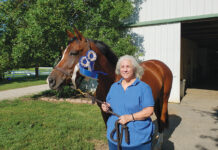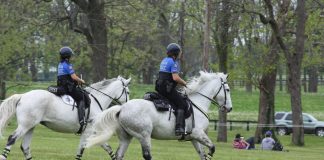As horse owners, it can be a little nerve-racking to introduce a new horse into an already established herd. You know the drill—Penny understands that Beans is the boss and respects her; Gerry the gelding knows that he shouldn’t mess with the mares but is great pals with Shelby the Shetland. The herd works; nobody gets hurt, everybody gets along.

1. Introduce by sight first
The key to a safe introduction is to take things very slowly. One way to start off is by allowing the new horses to see each other from a distance. Horses are extremely observant to their surroundings and to their routines, and most horses will recognize a new visitor from some distance away and become interested. To keep the old and new horses from becoming too excited, put the new horse in a nearby paddock, but don’t let him share a fence line with the regular herd. This way, the horses can get used to seeing (and perhaps smelling) each other without the danger of striking each other through a fence or running excessively. If this method still causes too much excitement, you may have to try it for only short periods of time at first.
2. Introduce with stalls
Another method for stress-free introductions is to put your new and old horses side-by-side in safe stalls. This works especially well if it’s only two horses that need to become acquainted. This way, the horses can directly touch each other without the danger of being turned out. It can be an excellent introductory method, and has the added advantage of helping you see if the horses are going to get along of if they seem to dislike each other. If they don’t get along in the stalls, they might not in the pasture, either.
3. Then put them out together
Once the horses seem calm and used to each other, you can actually try putting them together. They’ll likely approach each other and perhaps sniff and squeal a bit, but if they’ve spent enough time seeing and hearing each other and being stalled in proximity to each other, the encounter should be a reasonably peaceful one.
If the horses aren’t overly protective of their food, you could try putting out a couple of widely separated hay piles as a distraction, but don’t try this if you think it could lead to fighting. If your horses are on grass then you’re in fine shape already. Watch carefully over a few days; sometimes an equine personality conflict won’t become apparent right away. But if your new herd seems to be under control and happy, then you’re good to go!
Tips
- If you suspect kicking could be an issue, you can remove the hind shoes of your horses prior to turning them out together.
- New horses should be quarantined, ideally for a couple of weeks, before coming into direct physical contact with your other horses (buckets, brushes, and other tools should also be kept separate).
- Don’t leave a new situation unattended. Stay nearby with a bucket of grain and be ready to remove a horse if necessary.
- Make sure your pasture is safe and free of dangerous tight spots.
Liked this article? Here are others you’ll enjoy:
Five Things to Know Before Bringing Home a Rescue
Your New Horse







Good article. Sometimes “common sense” should be used first. Make sure you have a place to separate a new horse “before” you bring the new one home.
when we get a new horse in to board we have 8 horses already I have a ky mountain mare that stays with the new horse for 1 or 2 days and won’t let any of the other horse’s around it until the other horse’s are used to it. I have never saw anything like it.
Great advice.